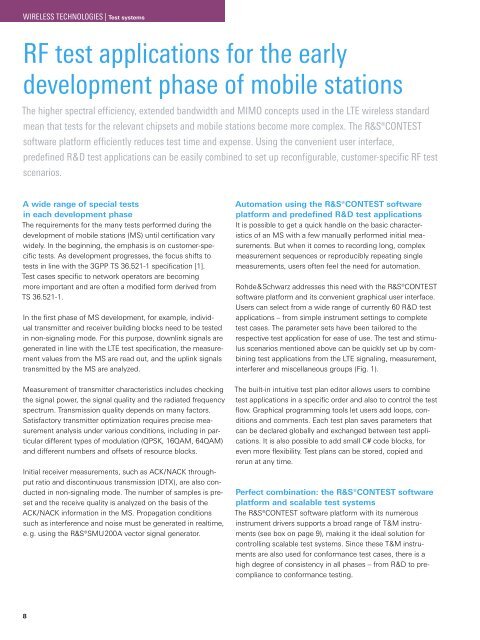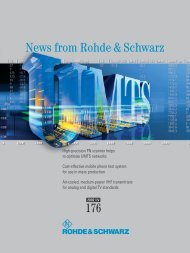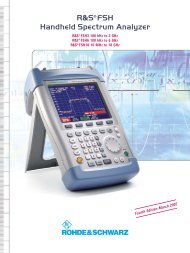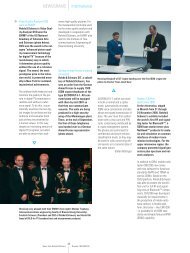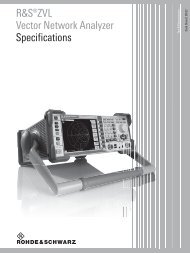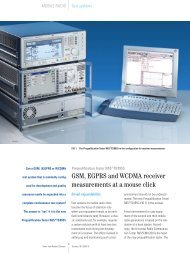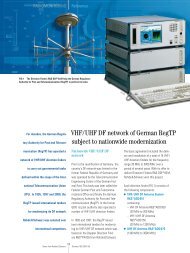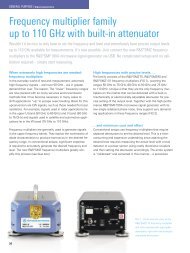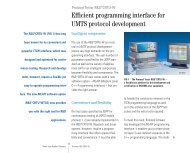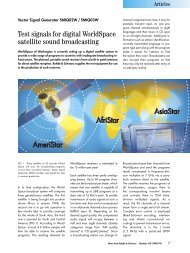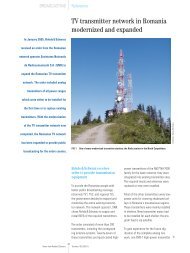RF test applications for the early development ... - Rohde & Schwarz
RF test applications for the early development ... - Rohde & Schwarz
RF test applications for the early development ... - Rohde & Schwarz
You also want an ePaper? Increase the reach of your titles
YUMPU automatically turns print PDFs into web optimized ePapers that Google loves.
WIRELESS TECHNOLOGIES | Test systems<br />
<strong>RF</strong> <strong>test</strong> <strong>applications</strong> <strong>for</strong> <strong>the</strong> <strong>early</strong><br />
<strong>development</strong> phase of mobile stations<br />
The higher spectral efficiency, extended bandwidth and MIMO concepts used in <strong>the</strong> LTE wireless standard<br />
mean that <strong>test</strong>s <strong>for</strong> <strong>the</strong> relevant chipsets and mobile stations become more complex. The R&S®CONTEST<br />
software plat<strong>for</strong>m efficiently reduces <strong>test</strong> time and expense. Using <strong>the</strong> convenient user interface,<br />
predefined R&D <strong>test</strong> <strong>applications</strong> can be easily combined to set up reconfigurable, customer-specific <strong>RF</strong> <strong>test</strong><br />
scenarios.<br />
A wide range of special <strong>test</strong>s<br />
in each <strong>development</strong> phase<br />
The requirements <strong>for</strong> <strong>the</strong> many <strong>test</strong>s per<strong>for</strong>med during <strong>the</strong><br />
<strong>development</strong> of mobile stations (MS) until certification vary<br />
widely. In <strong>the</strong> beginning, <strong>the</strong> emphasis is on customer-specific<br />
<strong>test</strong>s. As <strong>development</strong> progresses, <strong>the</strong> focus shifts to<br />
<strong>test</strong>s in line with <strong>the</strong> 3GPP TS 36.521-1 specification [1].<br />
Test cases specific to network operators are becoming<br />
more important and are often a modified <strong>for</strong>m derived from<br />
TS 36.521-1.<br />
In <strong>the</strong> first phase of MS <strong>development</strong>, <strong>for</strong> example, individual<br />
transmitter and receiver building blocks need to be <strong>test</strong>ed<br />
in non-signaling mode. For this purpose, downlink signals are<br />
generated in line with <strong>the</strong> LTE <strong>test</strong> specification, <strong>the</strong> measurement<br />
values from <strong>the</strong> MS are read out, and <strong>the</strong> uplink signals<br />
transmitted by <strong>the</strong> MS are analyzed.<br />
Automation using <strong>the</strong> R&S®CONTEST software<br />
plat<strong>for</strong>m and predefined R&D <strong>test</strong> <strong>applications</strong><br />
It is possible to get a quick handle on <strong>the</strong> basic characteristics<br />
of an MS with a few manually per<strong>for</strong>med initial measurements.<br />
But when it comes to recording long, complex<br />
measurement sequences or reproducibly repeating single<br />
measurements, users often feel <strong>the</strong> need <strong>for</strong> automation.<br />
<strong>Rohde</strong>&<strong>Schwarz</strong> addresses this need with <strong>the</strong> R&S®CONTEST<br />
software plat<strong>for</strong>m and its convenient graphical user interface.<br />
Users can select from a wide range of currently 60 R&D <strong>test</strong><br />
<strong>applications</strong> – from simple instrument settings to complete<br />
<strong>test</strong> cases. The parameter sets have been tailored to <strong>the</strong><br />
respective <strong>test</strong> application <strong>for</strong> ease of use. The <strong>test</strong> and stimulus<br />
scenarios mentioned above can be quickly set up by combining<br />
<strong>test</strong> <strong>applications</strong> from <strong>the</strong> LTE signaling, measurement,<br />
interferer and miscellaneous groups (Fig. 1).<br />
Measurement of transmitter characteristics includes checking<br />
<strong>the</strong> signal power, <strong>the</strong> signal quality and <strong>the</strong> radiated frequency<br />
spectrum. Transmission quality depends on many factors.<br />
Satisfactory transmitter optimization requires precise measurement<br />
analysis under various conditions, including in particular<br />
different types of modulation (QPSK, 16QAM, 64QAM)<br />
and different numbers and offsets of resource blocks.<br />
Initial receiver measurements, such as ACK/NACK throughput<br />
ratio and discontinuous transmission (DTX), are also conducted<br />
in non-signaling mode. The number of samples is preset<br />
and <strong>the</strong> receive quality is analyzed on <strong>the</strong> basis of <strong>the</strong><br />
ACK/NACK in<strong>for</strong>mation in <strong>the</strong> MS. Propagation conditions<br />
such as interference and noise must be generated in realtime,<br />
e.g. using <strong>the</strong> R&S®SMU200A vector signal generator.<br />
The built-in intuitive <strong>test</strong> plan editor allows users to combine<br />
<strong>test</strong> <strong>applications</strong> in a specific order and also to control <strong>the</strong> <strong>test</strong><br />
flow. Graphical programming tools let users add loops, conditions<br />
and comments. Each <strong>test</strong> plan saves parameters that<br />
can be declared globally and exchanged between <strong>test</strong> <strong>applications</strong>.<br />
It is also possible to add small C# code blocks, <strong>for</strong><br />
even more flexibility. Test plans can be stored, copied and<br />
rerun at any time.<br />
Perfect combination: <strong>the</strong> R&S®CONTEST software<br />
plat<strong>for</strong>m and scalable <strong>test</strong> systems<br />
The R&S®CONTEST software plat<strong>for</strong>m with its numerous<br />
instrument drivers supports a broad range of T&M instruments<br />
(see box on page 9), making it <strong>the</strong> ideal solution <strong>for</strong><br />
controlling scalable <strong>test</strong> systems. Since <strong>the</strong>se T&M instruments<br />
are also used <strong>for</strong> con<strong>for</strong>mance <strong>test</strong> cases, <strong>the</strong>re is a<br />
high degree of consistency in all phases – from R&D to precompliance<br />
to con<strong>for</strong>mance <strong>test</strong>ing.<br />
8
WIRELESS TECHNOLOGIES | Test systems<br />
Fig. 1 Quick and<br />
easy setup of <strong>test</strong><br />
scenarios using <strong>the</strong><br />
R&S®CONTEST software<br />
plat<strong>for</strong>m’s<br />
predefined <strong>test</strong><br />
<strong>applications</strong>.<br />
One task that continually recurs when combining <strong>test</strong> <strong>applications</strong><br />
<strong>for</strong> <strong>test</strong> systems is interconnecting <strong>the</strong> instruments. The<br />
resulting path transmissions have to be measured and taken<br />
into consideration during signal stimulation and measurement.<br />
The plat<strong>for</strong>m also provides <strong>applications</strong> <strong>for</strong> calibration<br />
and functional <strong>test</strong>ing of <strong>the</strong> system.<br />
Complexly interconnected instruments and <strong>RF</strong> components<br />
are easily handled with <strong>the</strong> R&S®CONTEST plat<strong>for</strong>m. Modeling<br />
of <strong>RF</strong> components and <strong>the</strong>ir connections ensures that<br />
<strong>the</strong> correct paths are selected and that <strong>the</strong> connected instruments<br />
are operated in <strong>the</strong> proper range based on <strong>the</strong> path<br />
properties. The software continually checks <strong>the</strong> feasibility of<br />
<strong>the</strong> requirements placed on <strong>the</strong> <strong>test</strong> system.<br />
As <strong>the</strong> <strong>development</strong> of an MS progresses, measurements<br />
are per<strong>for</strong>med in signaling mode, i.e. after a connection has<br />
been established between <strong>the</strong> simulated base station and <strong>the</strong><br />
MS. Developers have more flexibility when per<strong>for</strong>ming measurements<br />
because <strong>the</strong>y do not need to follow <strong>the</strong> LTE specifications<br />
exactly. They can adapt <strong>test</strong> scenarios to <strong>the</strong> current<br />
<strong>development</strong> phase of a DUT, e.g. with respect to <strong>the</strong> support<br />
The R&S®CONTEST software plat<strong>for</strong>m supports<br />
<strong>the</strong> following instruments:<br />
Signal generators<br />
R&S®SMU200A, R&S®SMBV100A, R&S®SMF100A, R&S®SMP<br />
Fading simulators<br />
R&S®AMU200A<br />
Signal / spectrum analyzers<br />
R&S®FSQ, R&S®FSG, R&S®FSU, R&S®FSP<br />
Network analyzers<br />
R&S®ZVK, R&S®ZVA<br />
Communications <strong>test</strong>ers<br />
R&S®CMW500<br />
Power supplies<br />
R&S®NGMO, R&S®NGSM<br />
Power meters<br />
R&S®NRP-Z, R&S®NRVD<br />
<strong>RF</strong> combining units<br />
R&S®TS-CONN, R&S®CMW-Z24<br />
<strong>RF</strong> switch plat<strong>for</strong>ms<br />
R&S®OSP, R&S®ISSCU, R&S®WSSCU, R&S®SSCU-MIMO<br />
Climatic chambers<br />
Vötsch, Espec, Thermotron, TestEquity<br />
NEWS 205/12 9
WIRELESS TECHNOLOGIES | Test systems<br />
of <strong>the</strong> 3A <strong>test</strong> mode or signaling characteristics. A convenient<br />
feature is <strong>the</strong> easy parameterization of R&D <strong>test</strong> <strong>applications</strong><br />
as shown in Fig. 2. In this scenario, <strong>the</strong> signal-to-noise ratio<br />
(SNR) is decreased until <strong>the</strong> ACK/NACK throughput ratio is<br />
less than 95 %.<br />
The R&S®CONTEST <strong>test</strong> report has been specially designed<br />
to meet R&D requirements. The standard report contains<br />
a sequential description of <strong>test</strong> sequences and conclusive<br />
graphs. Users can add comments to <strong>the</strong> report and, using <strong>the</strong><br />
intuitive report navigation, <strong>the</strong>y can zoom in to view wave<strong>for</strong>ms<br />
in detail and add comments (Fig. 3).<br />
When <strong>development</strong> of <strong>the</strong> MS nears completion, precompliance<br />
<strong>test</strong>s in line with 3GPP TS 36.521 [1] need to be per<strong>for</strong>med.<br />
During <strong>the</strong>se <strong>test</strong>s, more <strong>test</strong> conditions are simulated,<br />
e.g. different fading models and environmental<br />
influences such as temperature, humidity and power supply.<br />
The R&S®CONTEST <strong>test</strong> cases are based on <strong>the</strong> same measurement<br />
functions as <strong>the</strong> R&D <strong>test</strong> <strong>applications</strong>, ensuring<br />
easy comparison of measurement results. An MS is one step<br />
closer to certification when it has passed a number of <strong>test</strong>s<br />
in line with TS 36.521. The Global Certification Forum (GCF)<br />
and <strong>the</strong> PCS Type Certification Board (PTCRB) stipulate which<br />
<strong>test</strong>s have to be per<strong>for</strong>med.<br />
Fig. 2 Throughput<br />
measurement <strong>test</strong><br />
scenario.<br />
10
WIRELESS TECHNOLOGIES | Test systems<br />
Summary<br />
Simple operation, flexibility in <strong>test</strong> <strong>applications</strong> and automated<br />
<strong>test</strong> sequences that are easy to combine enhance <strong>the</strong><br />
efficiency of <strong>test</strong>s in <strong>the</strong> <strong>early</strong> <strong>development</strong> phase of an MS.<br />
The R&S®CONTEST software plat<strong>for</strong>m can be used <strong>for</strong> scalable<br />
<strong>test</strong> systems all <strong>the</strong> way through certification <strong>test</strong>ing. The<br />
software plat<strong>for</strong>m can also be used <strong>for</strong> simultaneous voice<br />
and data LTE (SVDLTE) measurements. It works perfectly<br />
toge<strong>the</strong>r with <strong>the</strong> R&S®TS8980 <strong>test</strong> system family, which<br />
consists of <strong>the</strong> R&S®TS-RRM radio resource management,<br />
R&S®TS8980L1 layer 1 <strong>RF</strong> <strong>test</strong>er, R&S®TS8980LBS location<br />
based services and R&S®CMW-PQA per<strong>for</strong>mance quality analysis<br />
<strong>test</strong> systems [2].<br />
Stefan Ballmann; Detlef Wiese<br />
References<br />
[1] 3GPP 36.521-1 V9.3.0 <strong>test</strong> specification, “User equipment (UE) con<strong>for</strong>mance<br />
specification; radio transmission and reception, part 1: con<strong>for</strong>mance <strong>test</strong>ing“.<br />
[2] R&S®TS8980 <strong>RF</strong> con<strong>for</strong>mance <strong>test</strong> system family <strong>for</strong> LTE and WCDMA / HSPA+.<br />
Article available on <strong>the</strong> internet (“News&Events”, “R&S News Magazine”,<br />
No. 202).<br />
Fig. 3 R&S®CONTEST<br />
<strong>test</strong> report with<br />
comments.<br />
NEWS 205/12 11


